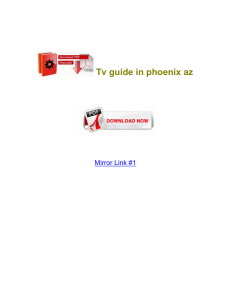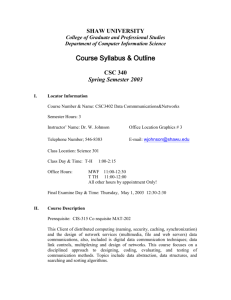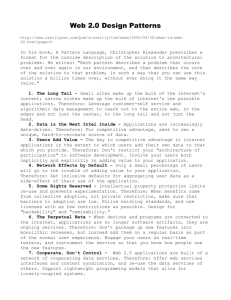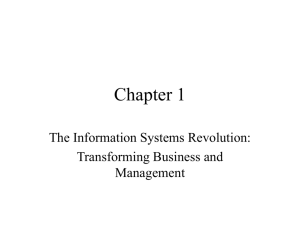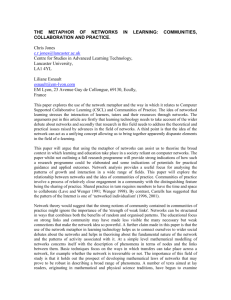pptx - UCL Computer Science
advertisement
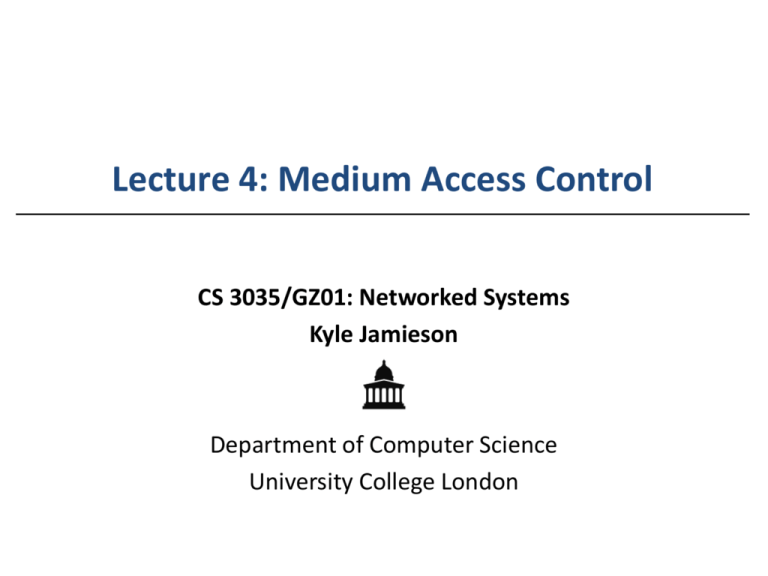
Lecture 4: Medium Access Control
CS 3035/GZ01: Networked Systems
Kyle Jamieson
Department of Computer Science
University College London
Structure of 3035/GZ01
1.
Start with architecture
– Protocols: How to structure
communication
– Layering: How to leverage modularity
2.
Then move to the lower layers
– Link technologies
– Coping with errors
3.
Study the “narrow waist” of IP
– IP best-effort forwarding
– IP addressing
– Routing: Intra-, Inter-Domain (BGP)
4.
Building on top of the narrow waist
– TCP reliable transport, congestion
control
– Domain name system (DNS)
– Security, web caching, CDNs
Networked Systems 3035/GZ01
2
Review: The data link layer
• Enables exchange of atomic messages (frames) between
end hosts
• Determine start and end of bits and frames (framing)
• Deliver information reliably
• Control errors (last lecture)
• Some link layers involve a shared medium
– e.g., Shared-wire Ethernet, satellite uplink, WiFi
– Today: Medium access control to share the medium
Networked Systems 3035/GZ01
3
Medium access: the problem
• Two questions:
1. How should the shared medium be divided?
2. Who gets to talk on a shared medium, and when?
• A medium access control (MAC) protocol specifies the above
• Three goals of a MAC protocol:
1. Efficiency
• High throughput (bits/second successfully received through
the channel)
• High utilization (throughput/raw channel rate)
2. Fairness: all hosts with data to send should get a roughly
equal share of the medium over time
3. Latency: want to minimize the time a host waits before being
granted permission to talk on the shared medium
Networked Systems 3035/GZ01
4
Physical limitation: finite speed of light
Boston via
Geosync Satellite
0.2 s
Hawaii
From London to:
58 ms
San Francisco
Mobile
Base station
WiMAX
Base station
Paris
43 ms
1.7 ms
10 μs
1 μs
WiFi AP
10−100 ns
3−30 m 300 m
3 km
343 km
8,645 km 12,000 km 73,000 km
Similar MAC protocols, vastly different timescales
Geosynchronous
Satellite
WiMAX
Base station
0.2 s
Packet radio:
ALOHA
10 μs
Ethernet
CSMA/CD
WiFi: CSMA/CA
10−100 ns
3−30 m
3 km
73,000 km
Today
1. Channel partitioning:
– Time division multiple access (TDMA)
– Frequency division multiple access (FDMA)
– Code division multiple access (CDMA)
2. Random access protocol: ALOHA
– Unslotted ALOHA
– Slotted ALOHA
3. Random access protocol: the Ethernet
Networked Systems 3035/GZ01
7
TDMA: Time Division Multiple Access
• Access to channel in “rounds”
• Each station gets fixed length slot (packet time) in each
round (unused slots go idle)
• Example: six stations, only 1, 3, and 4 have data to send
6-slot
round
1
3
4
1
3
4
Time
Networked Systems 3035/GZ01
8
FDMA: Frequency Division Multiple Access
• Channel spectrum divided into frequency bands
• Each station assigned fixed frequency band (unused
frequency bands are wasted)
FDM cable
Networked Systems 3035/GZ01
frequency bands
• Example: six stations, only 1, 3, and 4 have data to send
9
CDMA: Code Division Multiple Access
• CDMA is a medium access protocol used in wireless
networks
• All users transmit over the same frequencies, and at the
same time
• Another example of the use of codes
– But for sharing, instead of error control
• Codes allow multiple users to coexist and transmit
simultaneously with no interference, in theory
– In practice: performs well (many cellular mobile
telephone networks use CDMA)
Networked Systems 3035/GZ01
10
CDMA: User codes
• Each user n has her own binary “chip” code cn of length M
– Represent binary data and binary code using { 1, −1 }
– Encoding at user i:
• For each data bit dk, form M repetitions of dk, then
multiply the result, bit-by-bit, with cn
• e.g. (user 1, M = 8):
User 1 data:
User 1 code:
d1 = 1
d0 = -1
1 1 1
×
-1
-1 -1 -1
c1
Networked Systems 3035/GZ01
=
1 1 1
1
Channel output for user 1:
-1 -1 -1
1
-1
1 1 1 1 1 1
1
-1
1
-1
-1 -1 -1
-1 -1 -1
c1
11
CDMA: Code rate
• Chip rate = raw channel rate B
• Data rate = B/M (M times slower than raw channel rate)
• Overall code rate R = 1/M
• e.g. (user 1, M = 8):
User 1 data:
Rate: B/M
User 1 code:
Rate: B
d1 = 1
d0 = -1
1 1 1
×
-1
-1 -1 -1
c1
Networked Systems 3035/GZ01
=
1 1 1
1
User 1’s transmission:
-1 -1 -1
1
-1
1 1 1 1 1 1
1
-1
1
-1
-1 -1 -1
-1 -1 -1
c1
12
Decoding a single CDMA transmission
• Receiver hears Zi,m: mth chip for ith data bit
• To decode data bit i, receiver multiplies what it hears
M
with user 1’s code, chip by chip: di = 1 å Zi,m c1m
M m=1
Received
data Zi,m:
User 1 code:
-1 -1 -1
-1
1
-1 -1 -1
-1
×
1 1 1
1
-1
Networked Systems 3035/GZ01
1 1 1 1 1 1
1
=
1 1 1
-1 -1 -1
d0 = 1
d1 = -1
1
-1
-1 -1 -1
13
Sharing the medium with CDMA
• Let’s assume we have a way of:
– Synchronizing all users’ data bits in time
– Synchronizing all users’ chips in time
• In many shared mediums (e.g. wireless, but not optical), principle
of linearity applies:
– The channel sums the transmitted signals together, as shown:
User 1:
×
User 2:
×
Result: Wireless interference
Networked Systems 3035/GZ01
14
CDMA: Separating users’ transmissions
• As before, receiver selects user 1’s code c1, and
multiplies the received signal Zi,m by c1, chip by chip:
1 M
di = å Zi,m c1m
M m=1
• User 2’s interference is completely cancelled
Receiver
(listening to User 1):
Networked Systems 3035/GZ01
×
15
CDMA: How to choose codes
• Two users: user 1 (code c1), user 2 (code c2)
• When the receiver “tuned” to data bit 1 from user 1:
M
1
d11 = å Zi,m c1m
M m=1
1 M
= å( -c1m + cm2 ) c1m
M m=1
User 1:
User 2:
1 M
= å( -c1m c1m + cm2 c1m)
M m=1
Networked Systems 3035/GZ01
16
CDMA: How to choose codes
Orthogonality condition:
M
1 2
c
å mcm =0
m=1
M
1
d11 = å Zi,m c1m
M m=1
1 M
= å( -c1m + cm2 ) c1m
M m=1
User 1:
User 2:
1 M
= å( -c1m c1m + cm2 c1m)
M m=1
Networked Systems 3035/GZ01
17
Example of CDMA codes: Walsh codes
• nth user’s length-N Walsh code is the nth row of an N × N
Hadamard matrix H(N)
k -1 ù
éH 2k -1
é1 1 ù
H
2
k
ú
H(2) = ê
H
2
=ê
ú
k -1
k -1
-H 2 úû
ë1 -1û
êëH 2
( )
( )
( )
( )
( )
– Code rate: 1/N
– Supports up to N concurrent users
é H 2
( )
ê
H ( 4) =
ê H ( 2)
ë
Networked Systems 3035/GZ01
é
ê
H ( 2) ù
ú = ê
ê
-H ( 2) ú
û
ê
ë
1 1 1 1 ù
ú
1 -1 1 -1 ú
1 1 -1 -1 ú
1 -1 -1 1 úû
18
Do Walsh codes have the orthogonality property?
éH (2k -1 ) H (2k -1 ) ù
é1 1 ù
k
ú
H(2) = ê
H
2
=ê
(
)
ú
k -1
k -1
ë1 -1û
êëH (2 ) -H (2 ) úû
• Let’s look at the two rows of H(2)… yes!
• Assuming rows of H(2k−1) is orthogonal, let’s imagine a walk across
two rows of H(2k), multiplying them term-by-term
I. We pick two rows, both in upper or both in lower half
Product of the two is 0 + 0
I.
We pick one row in upper half, one in lower half, but same
respective rows of H(2k−1) Product of the two is 2k−1 − 2k−1
I.
We pick one row in upper half, one in lower half, but different
respective rows of H(2k−1) Product of the two is 0 + 0
Networked Systems 3035/GZ01
19
Today
1. Channel partitioning:
– Time division multiple access (TDMA)
– Frequency division multiple access (FDMA)
– Code division multiple access (CDMA)
2. Random access protocol: ALOHA
– Unslotted ALOHA
– Slotted ALOHA
3. Random access protocol: the Ethernet
Networked Systems 3035/GZ01
20
Random access MAC protocols
• When a station has a frame to send:
– Transmit at full channel data rate B
– No a priori coordination among nodes
• Two or more frames overlapping in time: collision
– Both frames are lost, resulting in diminished throughput
• A random access MAC protocol specifies:
– How to detect collisions
– How to recover from collisions
Networked Systems 3035/GZ01
21
ALOHAnet: Context
• Norm Abramson, 1970 at the University of Hawaii
– Seven campuses on four islands
– Want to keep campus terminals in contact with mainframe
– Telephone costs high, so build a packet radio network
Networked Systems 3035/GZ01
22
Unslotted ALOHA
• Simplest possible medium access control: no control at all,
anyone can just transmit a packet without delay
Node 1
Node 2
Node 3
Time
• Let’s assume that the probability a packet begins in any time
interval of length Δt is λ × Δt
– N senders in total, sending frames of time duration 1
– This is called a Poisson process with rate λ
• λ is the aggregate rate from all N senders
• Individual rate λ/N for each sender
Networked Systems 3035/GZ01
23
Unslotted ALOHA: Performance
• Suppose some node i is transmitting; let’s focus on i’s frame
Vulnerable period
I.
If others send between t0−1 and t0, their frames will overlap with the start of
i’s frame collision
II. If others send between t0 and t0+1, their frames will overlap with end of i’s
frame collision
III. Otherwise, no collision, and node i’s frame is delivered
• Therefore, there is a “vulnerable period” of length 2 around i’s frame
Networked Systems 3035/GZ01
24
Unslotted ALOHA: Performance
Vulnerable period
• What’s the chance no one else sends in the vulnerable period of length 2?
2l
Pr ( no send from one node in 2) = 1-
N
æ 2l ö
Pr ( no send at all in 2) = ç1÷
è
Nø
æ 2l ö
lim ç1÷
N®¥ è
Nø
Networked Systems 3035/GZ01
N -1
N-1
® e-2 l
25
Unslotted ALOHA: Utilization
Utilization
1/2e ≈ 18%
Too many collisions!
Not sending
fast enough
λ
• Recall from our definition of the Poisson process: λ is the
aggregate rate from all senders
• So, utilization = λ × Pr(no other transmission in 2)
= λe−2λ
Networked Systems 3035/GZ01
26
Today
1. Channel partitioning:
– Time division multiple access (TDMA)
– Frequency division multiple access (FDMA)
– Code division multiple access (CDMA)
2. Random access protocol: ALOHA
– Unslotted ALOHA
– Slotted ALOHA
3. Random access protocol: the Ethernet
Networked Systems 3035/GZ01
27
Slotted ALOHA
• Divide time into slots of duration 1, synchronize so that nodes
transmit only in a slot
– Each of N nodes transmits with probability p in each slot
– So aggregate transmission rate λ = N × p
• As before, if there is exactly one transmission in a slot, can
receive; if two or more in a slot, no one can receive (collision)
Node 1
Node 2
Node 3
...
Node N
Networked Systems 3035/GZ01
Time
28
Slotted ALOHA: Utilization
Suppose N nodes, each transmit with probability p in each slot.
What is the utilization as a function of aggregate rate λ = N × p?
• Pr[A node is successful in a slot] = p(1−p)N−1
• Pr[Success in a slot] = Np(1−p)N−1
Utilization
æ lö
Pr (success) = l ç1- ÷
è Nø
æ lö
lim l ç1- ÷
N®¥ è
Nø
1/e ≈ 37%
N-1
N-1
= l e- l
λ
Networked Systems 3035/GZ01
29
ALOHA throughput: slotted versus unslotted
1/e ≈ 36%
Slotted ALOHA: λe−λ
1/2e ≈ 18%
Unslotted ALOHA: λe−2λ
Just by forcing nodes to transmit on slot boundaries, we
double peak medium utilization!
Networked Systems 3035/GZ01
30
Today
1. Tour of medium access protocols (TDMA, FDMA,
CDMA)
2. Random access protocol: ALOHA
–
–
Unslotted ALOHA
Slotted ALOHA
3. Random access protocol: the Ethernet
Networked Systems 3035/GZ01
31
How did the Ethernet get built?
• Bob Metcalfe, PhD student at
Harvard in early 1970s
– Working on protocols for the
ARPAnet
– Intern at Xerox Palo Alto
Research Center (PARC), 1973
– Needed a way to network the
≈100 Alto workstations inbuilding
– Adapt ALOHA packet radio
• Metcalfe later founds 3Com,
acquired by HP in April ’10 for
USD $2.7 bn
Networked Systems 3035/GZ01
32
The Ethernet: Physical design
• Coaxial cable, propagation delay τ
– Propagation speed: 3/5 × speed of light
• Experimental Ethernet
– Data rate: B = 3 Mbits/s
– Maximum length: 1000 m
10 3 m
t= 3
» 5 ms
8
3 ´10 m/s)
5(
Propagation delay: τ
Networked Systems 3035/GZ01
33
Building the link: Framing bits
• Goal: Move bits from one place to another
– Sender and receiver have independent clocks
– No separate “clock signal” sent on the Ethernet
• Problem: Agree on clock tick period
• Problem: Agree on clock tick alignment (phase)
Networked Systems 3035/GZ01
34
How to encode bits?
• Simple binary encoding is called Nonreturn to Zero (NRZ)
– Drawback: Baseline wander prevents receiver from using
average of received signal to distinguish between 1 and 0
– Drawback: Clock recovery in the presence of long runs of 0s or
1s in the data
• Nonreturn to Zero Inverted (NRZI): Transition for a “1”, no
transition for a “0”
Networked Systems 3035/GZ01
35
Manchester (phase) encoding
• Manchester encoding:
• Exclusive-OR of the NRZ signal and the clock signal
• “0” is a low-to-high transition; “1” is a high-to-low
• Transition guaranteed on every bit
• “Phase encoding” in the experimental Ethernet [Metcalfe et al.]
• Drawback: Halves data rate
Networked Systems 3035/GZ01
36
4B/5B encoding
• So instead, later Ethernet standards use
a block code called 4B/5B
• Properties
– No code has more than one leading zero
– No code has more than two trailing zeros
– When sent back-to-back, no pair of 5-bit
codes contains more than three consecutive
zeros
• Encoding process:
1.
2.
Encode data using lookup table
Send coded bits with NRZI
Networked Systems 3035/GZ01
4-bit data
0000
0001
0010
0011
0100
0101
0110
0111
1000
1001
1010
1011
1100
1101
1110
1111
5-bit code
11110
01001
10100
10101
01010
01011
01110
01111
10010
10011
10110
10111
11010
11011
11100
11101
37
Ethernet framing
Preamble
Destination
Source
Data
CRC
8 bits
8 bits
4000 bits
16 bits
• Framing
– Beginning of frame determined by presence of carrier
– End of frame determined by absence of carrier
– Preamble: 10101010 produces a square wave that allows
receiver to frame bits
• CRC (Cyclic Redundancy Check) protects against errors
on the Ether
– Does not guard against errors introduced by the tap: rely on
higher-layer checksums
• Destination address allows filtering at the link layer
Networked Systems 3035/GZ01
38
Collisions
A
B
C
Z
Propagation delay: τ seconds
• Packet of N bits: N/B seconds on the wire
• From the perspective of a receiver (B):
– Overlapping packets at B means signals sum
– Not time-synchronized: result is bit errors at B
– No fate-sharing among receivers: C receives okay in this
example
Networked Systems 3035/GZ01
39
Who gets to transmit?
Carrier Sense Multiple Access
with Collision Detection (CSMA/CD)
1. Begin the transmission procedure at any time
2. Carrier sensing: never transmit a frame if you sense
that another station is transmitting
3. Collision detection: while sending, immediately
abort your transmission if you detect another
station transmitting
Networked Systems 3035/GZ01
40
Carrier sensing
• Mechanism: measure voltage on the wire
• Binary encoding: voltage depends on the data
• Manchester coding: constant average voltage
Networked Systems 3035/GZ01
41
Collision detection
A
B
C
Z
Propagation delay: τ seconds
• Paper isn’t clear on this point (authors did have a patent
in the filing process)
• Mechanism: monitor average voltage on cable
– Manchester encoding means your transmission will have a
predictable average voltage V0; others will increase V0
– Abort transmission immediately if Vmeasured > V0
Networked Systems 3035/GZ01
42
When does a collision happen?
A
B
C
Z
Propagation delay: τ seconds
• Suppose Station A begins transmitting at time 0
• Assume that the packet lasts much longer than τ
• All stations sense transmission and defer by time τ
– Don’t begin any new transmissions
• At time τ, will a packet be collision-free?
Only if no other transmissions began before time τ
Networked Systems 3035/GZ01
43
How long does a collision take to detect?
A
B
C
Z
Propagation delay: τ seconds
• Suppose Station A begins transmitting at time 0
• τ seconds after Z starts, A hears Z’s transmission
• When does A know whether its packet collided or
not? At time 2τ
Networked Systems 3035/GZ01
44
Collision detection and packet size
A
B
C
Z
Propagation delay: τ seconds
• How big must packets be for collisions to be detectable?
• Transmit rate B bits/second
• If packets take time 2τ, A will still be transmitting when Z’s
packet arrives at A, so A will detect collision
• So minimum packet size > 2τB bits
• Experimental Ethernet:
– τ = 5 μs, B = 3 Mbits/s 2τB = 30 bits
• Why doesn’t Metcalfe & Boggs paper mention this?
Networked Systems 3035/GZ01
45
Commercial Ethernet
A
B
repeater
C
Z
Propagation delay: τ seconds
• Commercial Ethernet
– Data rate B = 10 Mbits/s
– Maximum length: 500 m per segment with up to two repeaters
(hubs)
• Repeater receives bits, relays them onto wire
– τ = 20 μs worst case → 2τB = 400 bits = 50 bytes
– Could send complete packet; not see collision
Networked Systems 3035/GZ01
46
Resolving collisions
• Upon abort (carrier detect), a station enters the backoff
state
• Key idea: the colliding stations all wait a random time
before carrier sensing and transmitting again
– How to pick the random waiting time? (Should be based on
how stations have data to send)
– How to estimate the number of colliding stations?
• Goal: Engineer such that nodes will wait different
amounts of time, carrier sense, and not collide
Networked Systems 3035/GZ01
47
Slotted Ethernet backoff
• Backoff time is slotted and random
– Station’s view of the where the first slot begins is at the end of
the busy medium
– Random choice of slots within a window, the contention
window (CW)
• Goal: Choose slot time so that different nodes picking
different slots carrier sense and defer, thus don’t collide
Networked Systems 3035/GZ01
48
Picking the length of a backoff slot
• Consider from the perspective of one packet
1.
2.
Transmissions beginning > τ before will cause packet to defer
Transmissions beginning > τ after will not happen (why not?)
• Transmissions beginning < time τ apart will collide with packet
• So should we pick a backoff slot length of τ?
τ
Cause defer
OK
Networked Systems 3035/GZ01
Bad
τ
(Won’t
CS happen)
fail
OK
49
The problem of clock skew
• No! Slots are timed off the tail-end of the last packet
– Therefore, stations’ clocks differ by at most τ
– This is called clock skew Δ (−τ < Δ < τ)
• Suppose we use a backoff slot length of τ
– Different stations picking different slots may collide!
1
0
2
τ
τ
τ
τ
Station
Δ A, slot 1
Station B, slot 0
OK
OK
0
Networked Systems 3035/GZ01
1
2
50
Picking slot time in presence of clock skew
• Want other station’s other slots to be in “OK” region
– Then, transmissions in different slots won’t collide
– Worst case clock skew: τ
– So, pick a slot time of τ + τ = 2τ
0
2
1
τ
τ
Δ
2τ
2τ
OK
0
Networked Systems 3035/GZ01
2τ
2τ
1
OK
2
51
Binary exponential backoff
• Binary exponential backoff (BEB): double CW size on each
consecutive collision
• Stations wait some number of slots chosen uniformly at
random from CW = [0, 2m−1]
–
–
–
–
–
Reset m ← 1 upon a successful transmission
First retransmit (m = 1): pick from [0, 1]
Second retransmit (m = 2): pick from [0, 1, 2, 3]
…
Tenth and higher retransmissions (m ≥ 10): pick from [0, 1, …, 210−1]
• Observe: stations transmitting new frames don’t take into
account recent collisions, might transmit before stations in
backoff
Networked Systems 3035/GZ01
52
Enforcing consensus on collisions
A
B
C
Z
• Ethernet as described so far: collision at B and C but not at A or Z
• Lack of consensus results in differing backoff windows
• Metcalfe & Boggs: When a station detects collision, it “momentarily jams
the Ether to [ensure] that all other participants in the collision will detect
interference and, because of deference, will be forced to abort.”
• Result: All stations agree there was a collision, double backoff windows,
backoff, and retransmit
• Jamming signal of length 2τ suffices to enforce consensus
Networked Systems 3035/GZ01
53
Ethernet performance
• Divide time into
– Variable-sized contention intervals,
– Fixed size transmission intervals (of duration tpacket)
tpacket
Time →
Efficiency:
t packet
t packet + (2t )W
Number of slots to acquire the Ether
slot time
Networked Systems 3035/GZ01
54
Ethernet performance: Acquisition
• Suppose there are Q stations waiting to send
• Assume stations know Q and send with probability 1/Q
(BEB approximates this)
• What’s the probability
pacquire that one station
acquires the medium
without a collision?
Networked Systems 3035/GZ01
æ 1 ö æ 1 öQ-1
pacquire = Qç ÷ ç1- ÷
è Q øè Q ø
æ 1 öQ-1
= ç1- ÷
è Qø
1
»
e
» 37%
55
Ethernet performance: Waiting time
W: number of slots in a contention window before
acquisition of the Ether
• Probability of no wait: pacquire
• Probability wait one slot: (1 − pacquire)pacquire
• Probability wait two slots: (1 − pacquire)2pacquire
• E[slots to wait] = E[W] = (1 − pacquire)/pacquire
=e−1
Networked Systems 3035/GZ01
56
Today
1. Channel partitioning:
– Time division multiple access (TDMA)
– Frequency division multiple access (FDMA)
– Code division multiple access (CDMA)
2. Random access protocol: ALOHA
– Slotted ALOHA
– Unslotted ALOHA
3. Random access protocol: the Ethernet
Networked Systems 3035/GZ01
57
Comparing CDMA and ALOHA random access
• CDMA wireless
No interference between
transmitting stations
Adaptation to varying
numbers of users possible by
changing Hadamard matrix
✘ Reduced rate of individual
transmissions
✘ Unused codes waste overall
capacity
Networked Systems 3035/GZ01
• ALOHA random access
Stations can transmit using
the entire medium, at full
rate if alone
Almost-instant adaptation to
varying traffic loads
✘ Concurrent transmissions
result in collisions, loss of
throughput
58
Wireless Networks: 802.11
Pre-Reading: P & D Section 2.7, to 2.7.1 (inclusive)
NEXT TIME
Networked Systems 3035/GZ01
59

